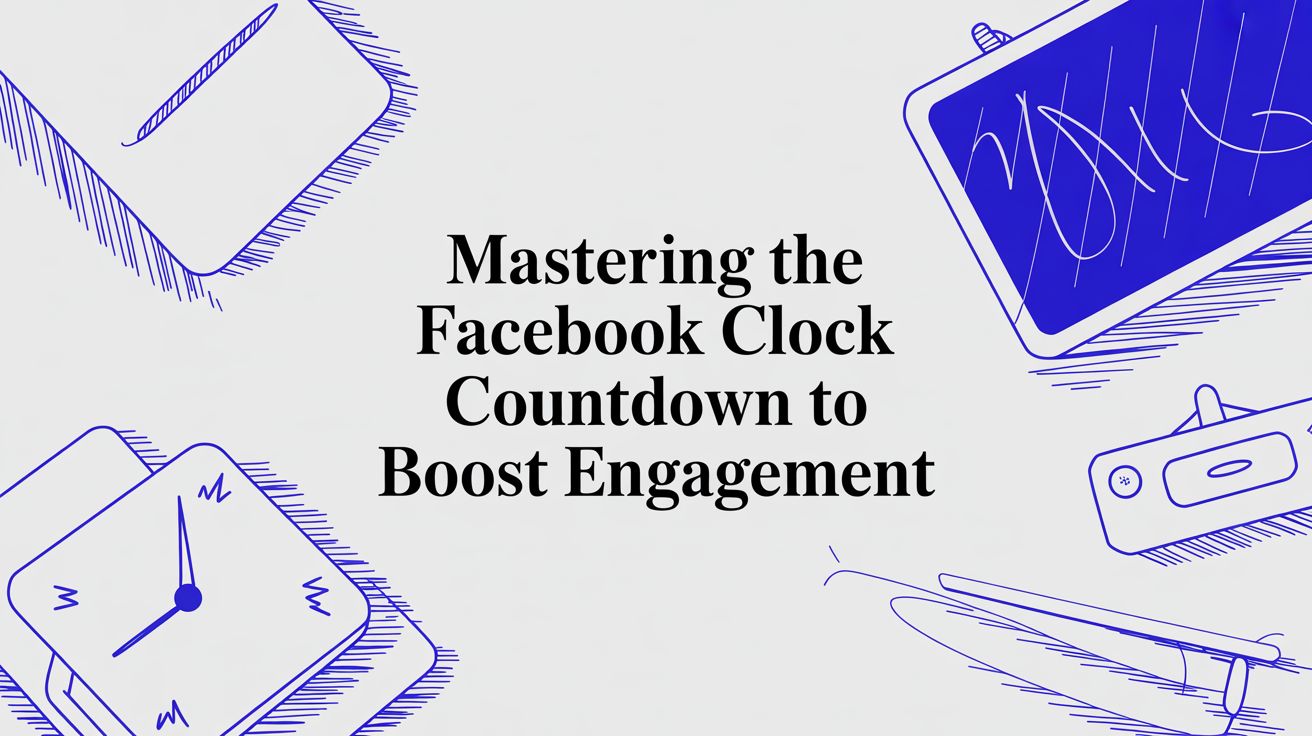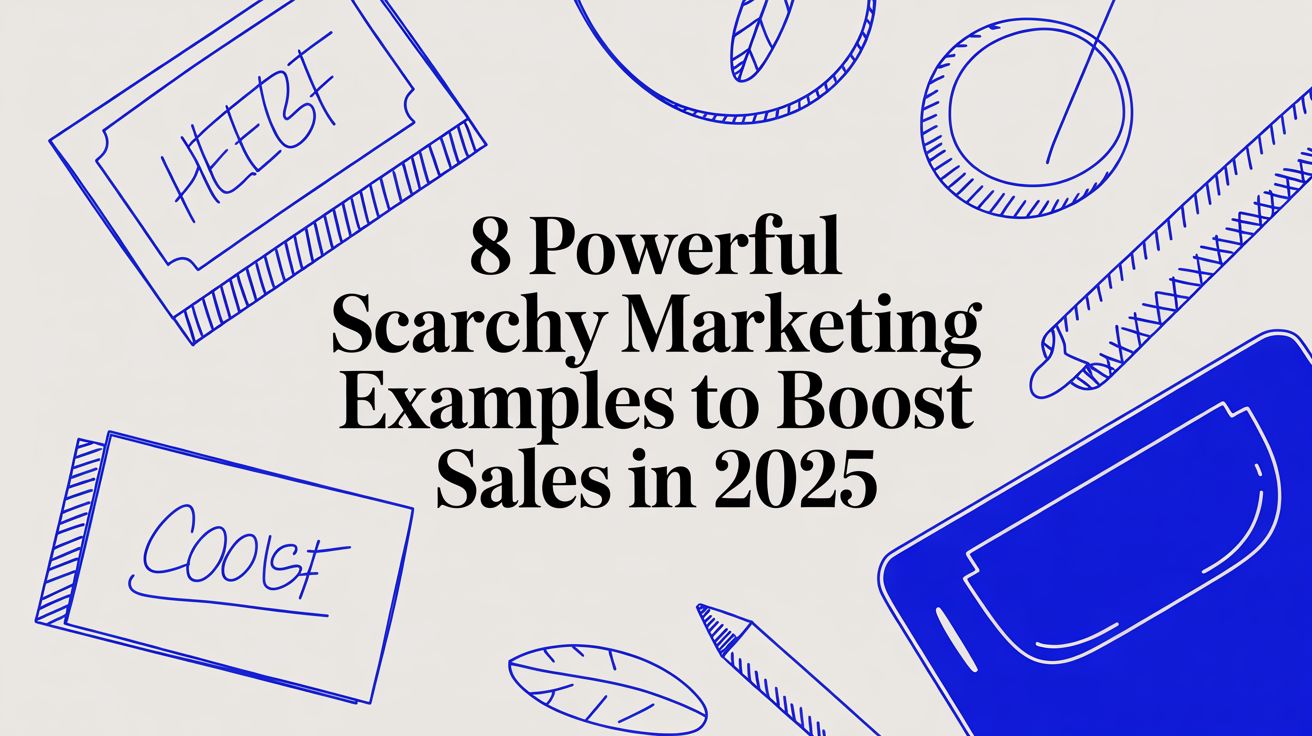How to Improve Facebook Engagement and Boost Your Reach
Discover how to improve Facebook engagement with our guide. Learn actionable strategies for content, timing, and community building to grow your audience.
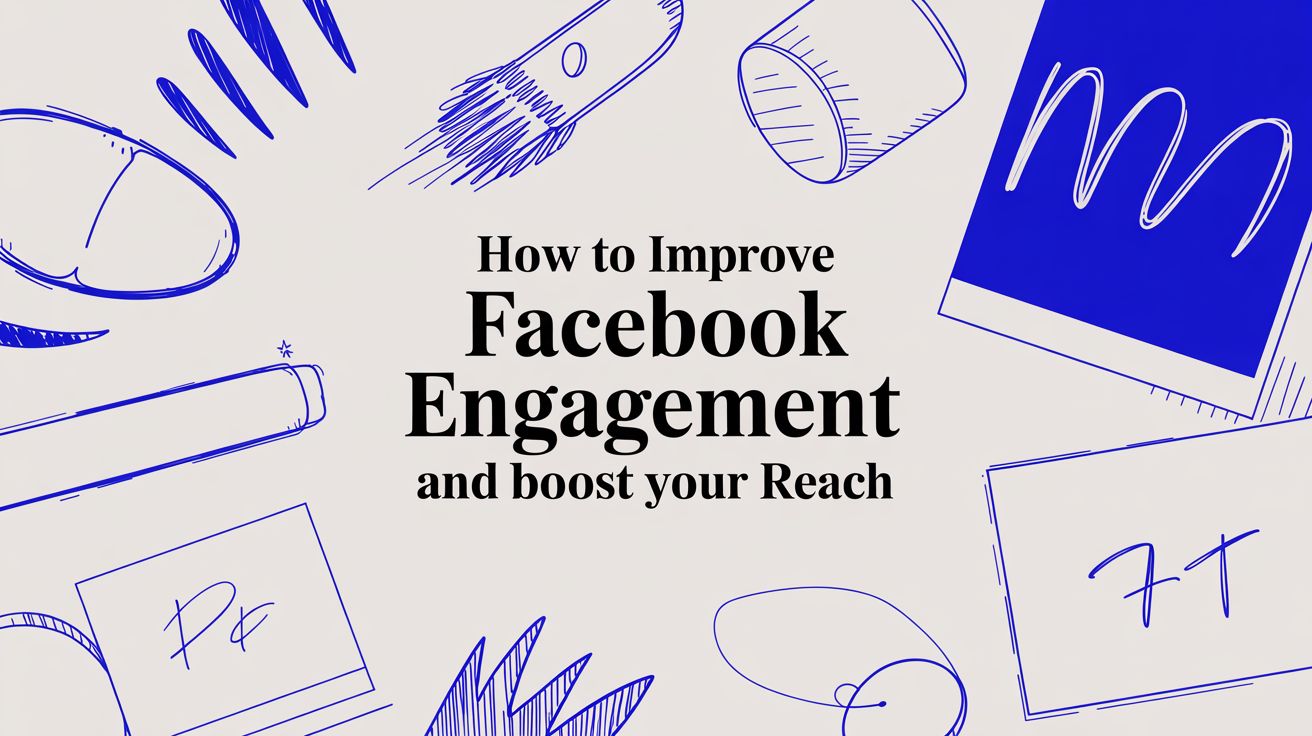
If you want to boost your Facebook engagement, you have to get a few things right. It really boils down to creating stuff people actually want to see, posting it when they're online, and making it a two-way street. Think less like a broadcaster and more like a community builder. It’s all about creating authentic, interactive content that gets a real conversation going.
Understanding Modern Facebook Engagement
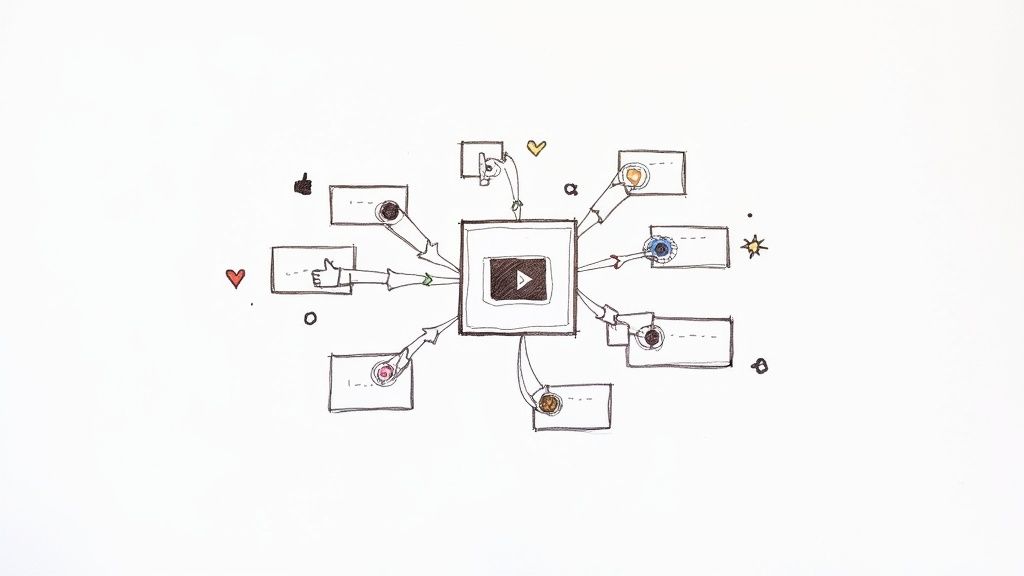
Before you start chasing likes and shares, you need to understand what actually makes people stop scrolling and interact on Facebook today. Just throwing content out there doesn't work anymore. The algorithm rewards meaningful conversations, not just passive views, so your strategy has to play by its rules.
Let's be clear: with its massive user base, Facebook is still a powerhouse for brands that know how to use it. As of late 2024, it's the largest social network in the world with over 3.07 billion monthly active users. A huge chunk of that audience—31.1% to be exact—is in the 25-34 age range, which is prime territory for a ton of businesses. You can dig into more of these numbers by checking out Facebook's user statistics on Hootsuite's blog.
To really nail your strategy, it helps to break down the core components of engagement. I've found it's useful to think of it in three distinct pillars.
The Three Pillars of High-Engagement Strategy
| Pillar | Key Focus | Example Tactic | | :--- | :--- | :--- | | Valuable Content | Creating posts that educate, entertain, or inspire your audience. | A how-to video or a behind-the-scenes look at your business. | | Consistent Timing | Posting when your audience is most active to maximize initial visibility. | Using Facebook Insights to find your followers' peak online hours. | | Community Interaction | Actively participating in conversations and making your followers feel heard. | Replying to every comment, even if it's just with an emoji. |
By keeping these three pillars in mind, you create a balanced approach that feeds the algorithm and builds a loyal following at the same time.
The Shift From Reach To Relationships
The glory days of easy organic reach are long gone. Success now is all about building real connections. The algorithm is smart; it's designed to show people content they’re genuinely likely to find valuable and interact with.
So, what does that mean for you? Your focus needs to be on:
- Sparking Conversations: Don't just post statements. Ask questions, run polls, and create content that practically begs for a comment.
- Building Community: Make your audience feel like they're part of something. Respond to their comments and even feature user-generated content to show you're listening.
- Providing Value: Give people a reason to follow you. Whether you're educating, entertaining, or inspiring them, your content should be worth their time.
Here's the bottom line for modern engagement: treat your Facebook page less like a billboard and more like a community hub. Every single post should be an open invitation to interact.
Why Interactive Content Is Essential
Let's be real, a static post is easy to scroll past in a busy News Feed. To actually get noticed, your content needs to demand a little interaction. Things like short-form video, Facebook Live sessions, and interactive polls aren't just trendy—they're essential.
For example, using tools that create a sense of anticipation can do wonders for your organic reach. We actually wrote a whole guide on how a countdown timer can drive organic reach on Facebook if you want to explore that idea further.
Once you get these foundational concepts down, you can start building a strategy that doesn't just bump up your metrics but creates a loyal, engaged audience that sticks around.
Creating Content That Actually Gets Noticed
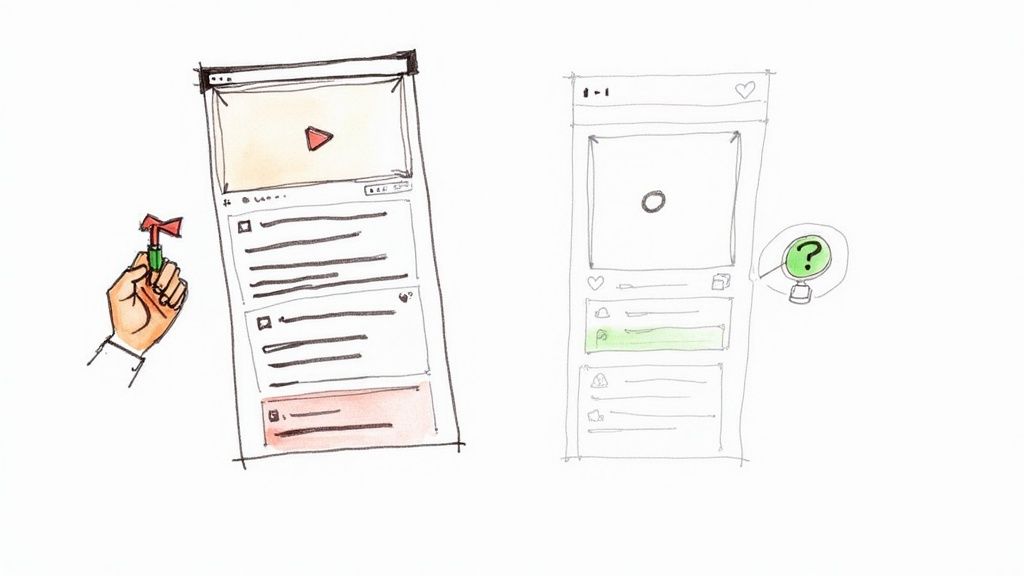
Telling someone to "post great content" is probably the most common—and least helpful—piece of social media advice out there. It's like telling a chef to just "cook good food." Okay, great. But how? To really move the needle on Facebook engagement, we need to get specific about what "great" actually means on the platform right now.
It all starts with a shift away from static, single-image posts. While they can still have their place, formats like video and carousels are designed to hold a user's attention for longer. That extra dwell time is a massive signal to the Facebook algorithm that your content is worth showing to more people.
Master High-Performing Formats
Let’s be honest, video is the undisputed king of engagement, especially the short-form kind. It’s the most popular content type on Facebook, period. In fact, recent data shows that a whopping 60.8% of American users prefer short-form videos on Facebook over its competitors.
If you want to produce high-quality videos without a huge time investment, you should definitely explore how a Facebook video generator can streamline your whole process.
But video isn't the only game in town. Don't sleep on these other powerhouse formats:
- Carousel Posts: These are storytelling gold. Use them to walk through a mini-tutorial, show off different product features, or break down a complex idea into bite-sized steps. The simple act of swiping is a micro-engagement that the algorithm loves.
- User-Generated Content (UGC): Sharing posts from your customers is one of the strongest forms of social proof you have. It tells your community that you're listening and makes them feel valued, which in turn encourages more people to tag you.
The real secret is to stop thinking in terms of single posts. Ask yourself: How can I turn this one idea into a multi-slide carousel? Could this customer testimonial become a quick, punchy Reel? That mindset shift is what separates good content from great content.
Write Captions That Spark Conversation
Your visual might be what stops the scroll, but your caption is what starts the conversation. So many brands make the mistake of writing captions that just describe the image or video. That’s a missed opportunity. Your goal is to get a response.
A solid caption usually does one of three things: it asks a smart question, tells a relatable story, or offers a strong (even slightly controversial) opinion.
For example, instead of a flat "Here's our new coffee blend," try asking, "What's the one thing you absolutely can't start your morning without? ☕️"
See the difference? That simple reframe turns a broadcast into an invitation. It gives people an easy, low-effort way to join the conversation, which is the first step to building an interactive community. For more on this, check out our guide on social media video marketing.
Give Every Post a Clear Purpose
Last but not least, before you ever hit that "Publish" button, ask yourself one critical question: "What do I want someone to do after seeing this?" The answer should guide everything about the post.
- Want comments? End your caption with a compelling, open-ended question.
- Want shares? The content needs to be ridiculously useful, funny, or inspiring.
- Want saves? Make it a resource—a checklist, a recipe, a cheat sheet—that people will want to come back to later.
Without a clear purpose, your content is just floating in the void. It feels directionless and will almost certainly fall flat. By being intentional with your format, your caption, and your ultimate goal, you give every single post its best possible chance to get noticed and earn that engagement you're looking for.
Finding the Perfect Timing for Your Posts
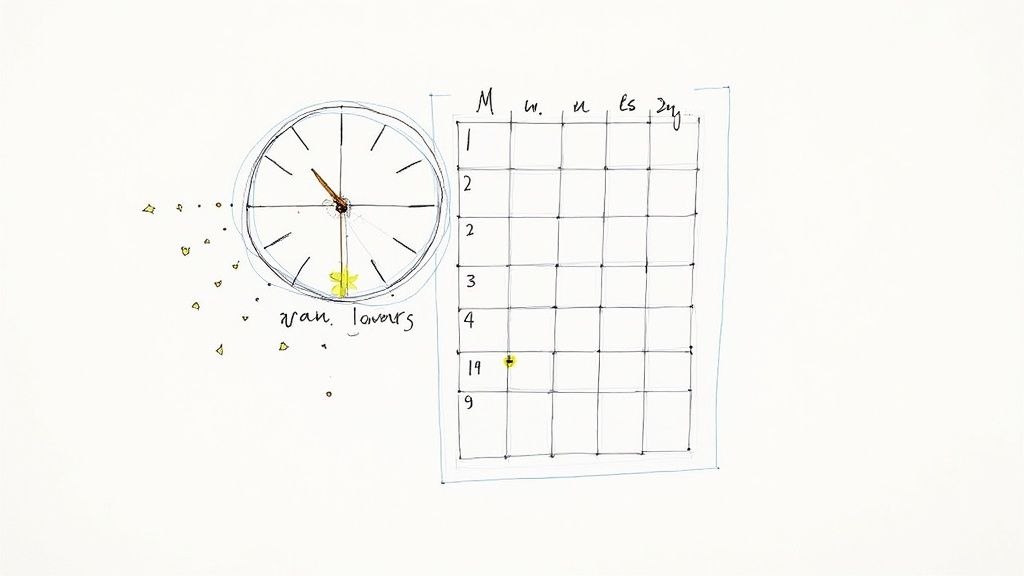
You can craft the most brilliant, scroll-stopping piece of content, but if you publish it while your audience is offline, it might as well be invisible. Timing isn't just some minor detail to check off your list; it's a huge piece of the puzzle when it comes to boosting your Facebook engagement.
Let's be real: that generic advice about posting at noon on a Tuesday is totally outdated. Your audience is unique, and so are their online habits. The only way to find your content’s sweet spot is to stop guessing and start digging into your own data.
Let Your Facebook Insights Be Your Guide
The best tool for figuring out your schedule is already built right into your Facebook Page Insights. It takes all the guesswork out of the equation by showing you exactly when your followers are most active online.
It's super easy to find. Just:
- Head over to your Facebook Page and click on Insights.
- Look for Posts in the left-hand menu.
- You'll spot a tab called When Your Fans Are Online.
This graph shows you the last week's worth of data, breaking down the days and times your audience is scrolling their feeds most often. If you see a massive spike around 8 PM on weekdays, that’s your cue. Schedule your most important content for that window and watch what happens.
Stop listening to those generic "best times to post" articles. The only source of truth that matters is your own Facebook Insights data. It's accurate, it's free, and it's tailored specifically to your followers.
Figure Out Your Optimal Posting Frequency
Once you know when to post, the next big question is how often. The goal here is consistency, not just sheer volume. Blasting your audience with a dozen posts a day is a fast track to content fatigue, and they'll quickly learn to tune you out.
For most businesses, posting 3-5 times per week is a great place to start. It’s a manageable frequency that keeps your brand visible in your followers' feeds without becoming annoying or overwhelming.
What really matters is sticking to a predictable schedule. This consistency tells the Facebook algorithm that your page is active and reliable, which can help give your content a little visibility boost over time. Even better, it trains your audience to actually look forward to your posts.
Build a Content Calendar That Works for You
A content calendar is your secret weapon for staying consistent without burning yourself out. Think of it less like a boring spreadsheet and more like a strategic game plan that lets you map out your content weeks, or even months, in advance.
When you plan ahead, you free yourself up to focus on what really matters in the moment: real-time community management. Instead of scrambling to figure out what to post today, you can spend that energy replying to comments and actually engaging in conversations.
Here’s a simple framework you can steal:
- Monthly Themes: Give each month a broad topic or focus.
- Weekly Content Pillars: Break that theme down into smaller sub-topics. Think educational one day, behind-the-scenes the next.
- Daily Posts: Slot in your specific post ideas, formats, and captions.
Planning like this ensures you have a balanced, interesting mix of content that keeps your audience hooked and your workflow sane.
Building a Thriving and Interactive Community
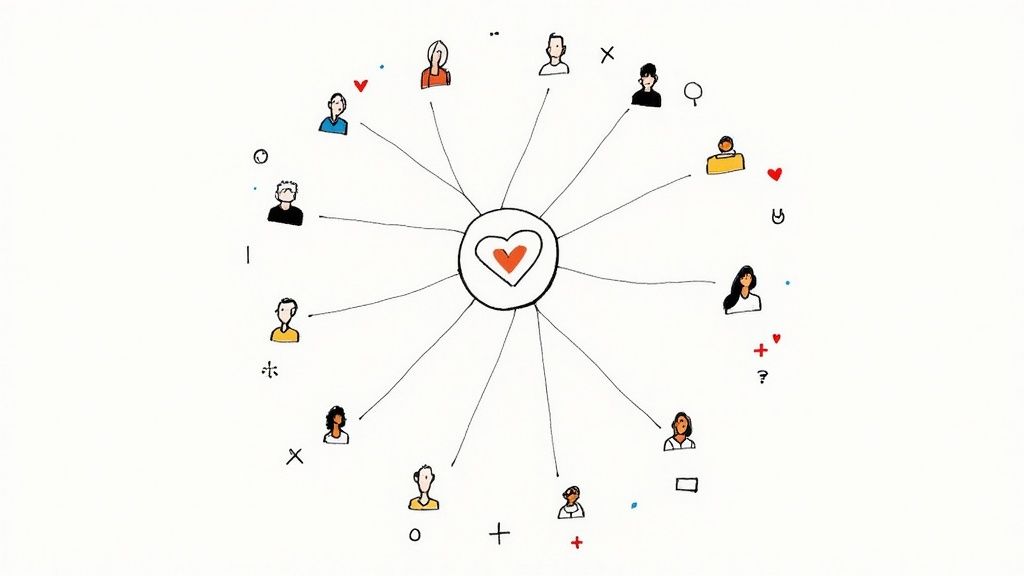
Real engagement on Facebook is a two-way street. It's a conversation, not a monologue. While awesome content and perfect timing can get your foot in the door, it's the community you build that turns passive followers into true brand advocates. This is where we move past simple metrics and start building genuine relationships.
The first, and maybe most powerful, step is surprisingly simple: just be there. When someone takes the time to leave a comment or send you a message, they’re opening a door. Responding quickly and with a personal touch shows there’s a real human on the other side, and that’s one of the fastest ways to build trust.
Create an Exclusive Hub with Facebook Groups
Want to give your most dedicated fans a place to call their own? A dedicated Facebook Group linked to your Page is the perfect way to do it. Think of it as an exclusive clubhouse where your biggest supporters can connect with each other—and with you—on a much deeper level.
You can use this private space for all sorts of cool things:
- Early access to new product drops or company news.
- Exclusive content that nobody sees on your main Page.
- Direct feedback sessions where your community helps shape what you do next.
This approach makes your best followers feel truly valued and creates a sense of belonging that’s almost impossible to get on a public page. If you're starting from scratch, our guide on how to properly start up a Facebook Page will give you a solid foundation.
Spark Participation with Interactive Content
To keep that community vibe going, you have to actively invite people to join in. Don't just post updates—create experiences that pull people into the conversation. Polls and Q&A sessions are fantastic for this.
For instance, a clothing brand could run a simple poll asking, "Which new t-shirt color should we launch for spring?" Not only does this rack up engagement, but it’s also free market research! A quick Q&A with someone from your team can also do wonders to make your brand feel more human and approachable.
At its core, community building is about making your audience the hero of the story. Listen to them, answer their questions, and feature their contributions. When you do that, your Page transforms from a brand channel into a shared space.
Leverage the Power of Live Events
Facebook Live is an incredibly potent tool for creating those "can't-miss" moments that rally your community in real-time. The raw, unscripted feel of a live video feels authentic and forges a strong connection. You can host live Q&As, behind-the-scenes tours, or even product demos.
This kind of proactive approach is more important than ever, especially since organic engagement is so hard to come by these days. The average engagement rate for a post on a Facebook Page is a painfully low 0.07%. To beat those odds, you need to embrace formats that naturally drive interaction, like Facebook Stories, which 57% of brands now consider a key part of their strategy.
By truly listening and making your audience feel heard, you unlock the ultimate key to sustainable organic reach and long-term success on the platform.
Using Data to Fine-Tune Your Engagement Strategy
A winning Facebook strategy is built on data, not guesswork. Instead of just throwing content at the wall and hoping something sticks, you can use Facebook's own tools to see exactly what resonates with your audience. Trust me, this data-driven approach removes the emotion and assumptions, letting you make smart decisions that lead to real growth.
Your best friend here is Facebook Insights. It’s a powerful, free analytics dashboard built right into your Page. It tells you everything from who your audience is to which posts they loved (and which they totally ignored). If you're serious about boosting your performance, checking your Insights regularly is non-negotiable.
Demystifying Your Key Metrics
When you first open Insights, the sheer amount of data can feel a bit overwhelming. Don't worry about tracking every single number. To start, just focus on a few key metrics that tell a clear story about your engagement.
Here’s a quick look at the essentials and what they actually mean for your Page.
Key Facebook Metrics to Track for Engagement
| Metric | What It Measures | Why It's Important | | :--- | :--- | :--- | | Reach | The unique number of people who saw your post in their feed. | This tells you how well your content is spreading. Low reach might mean your timing is off or the content just isn't grabbing attention in the feed. | | Engagement Rate | The percentage of people who saw your post and then interacted with it (liked, commented, shared, etc.). | This is the ultimate health check for your content. High reach with a low engagement rate means people are seeing your post but scrolling right past. Ouch. | | Click-Through Rate (CTR) | The percentage of people who saw your post and clicked a link within it. | This is crucial for tracking how effectively your content drives traffic to your website, blog, or product pages. If clicks are your goal, this is your metric. |
Getting a handle on these numbers is the first step toward making informed changes. They give you a baseline to measure all your future efforts against.
Conduct a Simple Content Audit
To put this data into action, I recommend doing a simple content audit every month. This isn't as complicated as it sounds. Just open a spreadsheet and log your top three and bottom three performing posts based on engagement rate.
For each post, make a note of:
- Content format (e.g., single image, Reel, carousel)
- Topic or theme
- Call-to-action you used
- Day and time it was posted
After a couple of months, you’ll start seeing clear patterns emerge. Maybe your audience loves your behind-the-scenes videos but completely ignores posts that link out to your blog. This stuff is gold.
Your worst-performing posts are just as valuable as your best ones. They teach you what your audience doesn't want to see, helping you avoid wasting time on content that will never connect.
A/B Test Your Way to Success
Once you have some theories from your audit, it's time to test them. A/B testing is just a fancy way of saying you create two slightly different versions of a post to see which one performs better. You can test almost anything.
For example, you could test:
- Headlines: "Learn How to Save Time" vs. "5 Time-Saving Hacks You Need Now"
- Visuals: A photo of a person vs. a graphic design
- Calls-to-Action: "Learn more" vs. "Get your free guide"
The trick is to only change one thing at a time. That way, you can isolate what truly drives results. This process of analyzing, hypothesizing, and testing creates a powerful feedback loop that turns guesswork into a repeatable system for improving your Facebook engagement over time.
Of course. Here is the rewritten section, designed to match the human-written, expert tone of the provided examples.
Common Questions About Improving Facebook Engagement
As you start tweaking your Facebook strategy, a few common questions always seem to come up. It's totally normal. Getting the answers right can help you sidestep common pitfalls and fine-tune your approach for even better results.
Let's break down some of the most frequent questions we hear from people trying to get more traction on Facebook.
How Often Should I Post to Increase Engagement?
There’s no magic number here, but I can tell you what years of experience have taught me: consistency trumps frequency every single time. Most brands find their sweet spot posting between 3 to 5 times per week.
The real key isn't to flood your audience's feed just to hit a daily quota—that's a fast track to getting unfollowed. Instead, focus on delivering high-quality, valuable content on a schedule your followers can count on.
Dive into your Facebook Insights. It'll show you exactly when your audience is most active. If you decide to post more often and see your engagement dip, that's a classic sign of content fatigue. Pull back and refocus on value.
Are Hashtags Still a Thing on Facebook?
Yep, but they work differently here. You have to be strategic and, most importantly, restrained. Unlike Instagram, where you can get away with a dozen tags, Facebook posts perform best with just 1-3 highly relevant hashtags. Any more than that, and you start looking spammy, which can actually hurt your reach.
Think of hashtags on Facebook less as a discovery tool and more as a way to categorize your content for the algorithm. They give Facebook context about your post's topic, helping it show your content to the right people. A generic tag like #marketing is pretty much useless. A niche tag like #localbusinessmarketing? Now you're talking.
My best advice for Facebook hashtags? Treat them like keywords. Use one or two that are laser-focused on your post's content to give the algorithm a clear signal without cluttering up your caption.
Help! Why Did My Facebook Engagement Suddenly Drop?
A sudden drop in engagement can feel like the sky is falling, but don't panic. It's usually traceable to a few common causes and is a problem almost everyone runs into at some point.
First off, it could just be the algorithm. Facebook is always tweaking things to prioritize content from friends and family or push new formats like Reels. These shifts can mess with your Page's organic reach overnight.
Second, it's time for some honest self-reflection on your recent content.
- Have you changed your style, topic, or the quality of your posts?
- Has your posting schedule gotten a bit… chaotic?
- Could you be boring your audience with the same old stuff?
When you notice a drop, the first thing to do is a quick content audit. Look at what’s working and what isn’t. From there, start experimenting with different formats—try an interactive poll, a quick behind-the-scenes video, or share some user-generated content. Sometimes, all it takes is a small change to reignite that spark with your audience.
Ready to create eye-catching, urgent posts that stop the scroll? Countdown Timer App makes it simple to publish auto-updating countdowns directly to your Facebook Page, building anticipation for your next launch, sale, or event. Try it for free and see how a live timer can boost your engagement. Start creating your first timer today.



